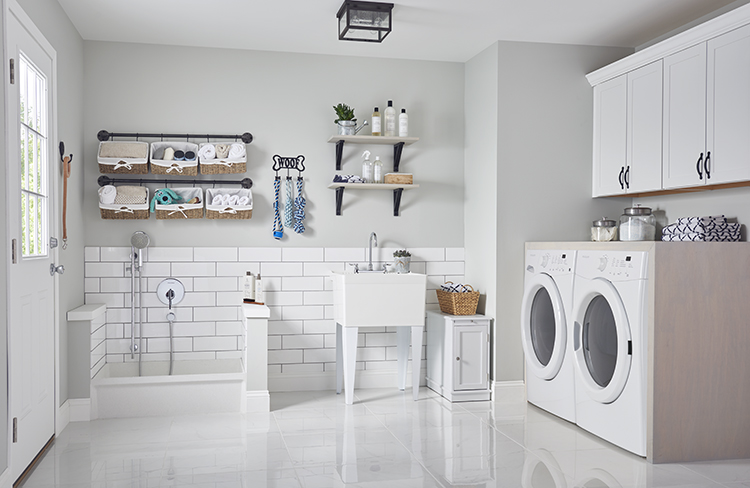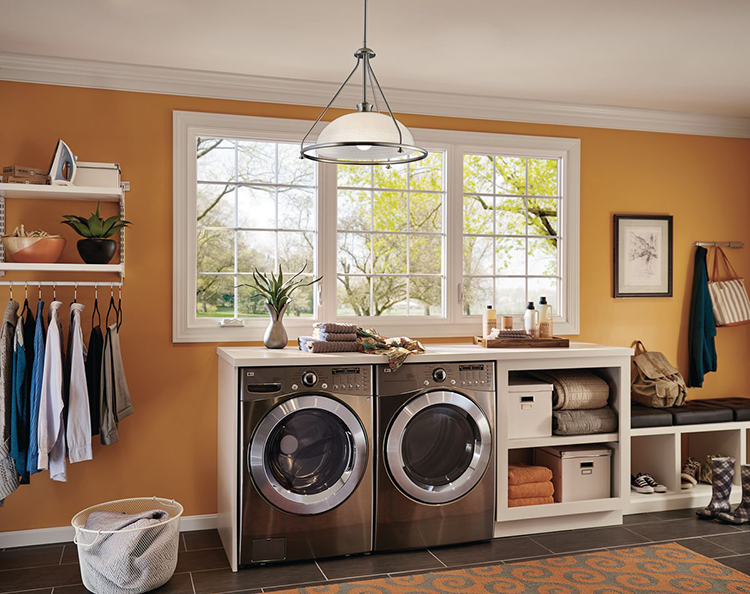Style & Design
Designing a Utility Room to Meet Your Needs
One of the most used rooms in the home after the bathroom and kitchen is the utility room, yet it is often the one most neglected when it comes to considering its layout and features. Whether yours is a separate laundry room, mudroom, workshop, or a simple corner in the garage or basement, a well thought-out and designed utility room can make your household tasks more efficient and enjoyable.

Whether your utility room is strictly a laundry room or it serves multiple purposes, creating a functional and organized space will help you maximize its usefulness.
Since you spend so much time in it, your utility room should reflect your lifestyle and simplify your daily routines. Plan your room around the habitual tasks it will be used for and design according to these needs.
The most common type of utility room is a laundry room. Some serve only this function while others are a combination mudroom and laundry area. Whether it's located in the basement or on the main floor of your home, you probably spend a lot of time using it so making it more organized, multifunctional, and efficient will help you maximize its usefulness.
Create Separate Work Zones
Regardless of the size of your utility room, consider dividing the area into separate zones to make it more efficient. Since most utility rooms involve cleanup projects of some sort, some common types of zones are: dirty area, clean area, and work space. Each of these three zones will differ in size and organization based on the room's space allocation.

Installing hidden hampers to toss soiled clothes into during the week or separate bins to pre-sort the dirty laundry into separate loads such as whites, darks, special care, etc. will make your room more efficient.
Dirty area
For laundry rooms, have a hamper to toss soiled clothes into during the week or separate bins to pre-sort the dirty laundry into separate loads such as whites, darks, special care, etc. If you have room, a place such as a counter with a built-in laundry sink to pretreat stained items is a good idea. It can be used for washing hands, soaking soiled sports gear or other items, or even for potting plants.
For multipurpose rooms, a larger utility sink comes in handy for a variety of tasks such as cleaning up after gardening, painting, outdoor sports and activities, and even washing the family dog without tracking dirt and mud throughout the house to use a bathroom or kitchen sink to clean up extra messes. A handheld shower head is ideal for these types of cleaning chores, so be sure to add one to your utility sink. If budget and space allows, a separate wash station is great for these kinds of tasks.
Clean area
A designated clean area can be used to hang wet clothes to line dry on a rack or a staging area for sorting clothes as they come out of the dryer. Good choices for hanging rack include bars such as those used in closets, a portable or wall-mounted fold-up rack, or a retractable clothes line.
Work area
This is the area to keep your ironing board, countertop space or work table for folding clothes, or doing functions other than laundry. You can also keep cleaning supplies, sports or pet gear, or other tools and items you need in cabinets, on shelves, or in bins in this area so they’re easy to access.
Things to Consider in the Overall Space
Shine a light on it
Most utility rooms lack natural light so task lighting is a must to illuminate specific work zones. Besides ceiling fixtures to brighten the room, undercabinet lighting can make it easier to see the tasks at hand.

Add cabinets or storage spaces whenever possible to hide cleaning and work supplies. Hooks and holders on the wall are a great option for limited space to hang tools, laundry bags, clean clothes, or other items while still keeping them in easy reach.
Add a place to store your stuff
You need a place to stash cleaning and work supplies so installing some cabinetry or storage closets is a must. If space is tight, go with just a top cabinet above the washer and dryer. For larger rooms, upper and lower cabinets give you more options for hiding supplies and laundry baskets or bins out of sight.
Use organizers inside to keep items tidy. Hooks and holders on the walls or on the door can hold a variety of items such as empty laundry bags, jackets, pet leashes, or other items within easy reach and help keep your room clutter-free.
Water, water everywhere
As in your bathroom and kitchen, water-resistant materials are a must. For flooring, vinyl, stone, and ceramic tile are durable, easy-to-clean, and impervious to water spills and leaks. Invest in a laundry shut-off valve to help prevent leaks from becoming a problem should your washer or hose line suffer a malfunction, or to prevent them when you’re away from home for any length of time.
Keep your cool
Running multiple loads of laundry can heat up a small room. Keep cool while you go about your tasks by installing a ceiling fan or ventilation fan in the room to keep fresh air circulating and humidity levels down.
Regardless of its primary use, your utility room doesn't have to be a dull or boring spot to toss your dirty laundry and muddy shoes. With a little planning and design inspiration, you can make it cool, comfortable, pleasant, and highly functional.









